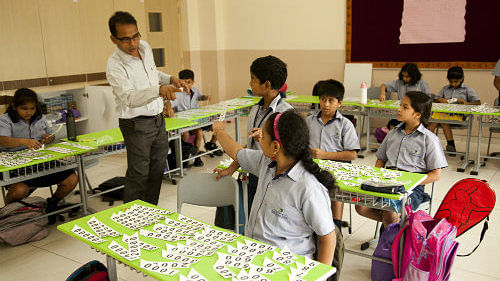New Delhi: Imagine a trip to Mars or Saturn or any planet of your choice and write a “travelogue” about how you think the trip would be. Hear the flute and learn in real-time the physics behind making music out of a few holes poked into a hollow wooden stick. Recite poems like Amitabh Bachchan spoke his dialogues in those 1970s Bollywood blockbusters, and think of chemistry as an exercise in social interactions.
Several schools across India are making lessons more interesting by employing a host of novel techniques that help students think beyond textbooks and rote learning.
The initiatives stem from a Central Board of Secondary Education (CBSE) circular issued to schools this April, on the threshold of the 2019-20 academic year. In the circular, the CBSE advised schools to infuse teaching with art and listed a host of ways to do it, like the Bollywood push and space travelogue (the board suggested imagined trips to an ocean or forest of one’s choice, too).
The schools took note, and have since added some measures of their own, including the flute instruction.
Science through art
Vamsi Krishna, the principal of Delhi Public School, Surat, told ThePrint that the institute was now teaching physics and chemistry through arts.
“We teach science subjects like physics and chemistry through music and dance. For example, our flute teacher plays the flute and explains the science behind it, why a certain kind of sound is coming out of the flute and how the wind direction is affecting it,” he said.
“Then we teach chemistry, periodic tables by using dance forms. We use a dance form to depict the origin of a certain metal or a compound,” Krishna added.
According to Krishna, the CBSE’s instructions were simple enough that they could be adopted by schools with the most basic infrastructure.
“The CBSE’s suggestions are basic… Many schools are following them but they can, of course, use their own creativity and come up with more methods like we are doing,” he added.
The CBSE suggestions include lessons in chemistry where each of the students plays a certain element and decides who they mingle with based on the qualities of the element they represent. For example, a student playing Helium would probably find themselves sitting on their own, because “He” doesn’t react with other elements.
Another CBSE suggestion involves a touch of Bollywood: Learning the meaning and lines of a difficult poem by breaking each of them into a “dialogue by Amitabh Bachchan or James Bond or set to music based on Bollywood songs”.
Also read: ‘Students losing interest’, NCERT gets book to teach maths through rhyme, riddle & story
Out of the box
Springdales School, Delhi, principal Ameeta Mulla Wattal said they were now taking students to historical monuments and playgrounds for lessons in maths.
“We take students to historical monuments, say, for example Humayun’s Tomb, where they can see the architecture of the monument and understand different angles and shapes from the monument,” she added. “We encourage students to draw the monument to give them an understanding of the architecture… because all that is taught in classrooms is of no use if it cannot be applied practically,” Wattal said.
“Then, we teach them about concepts like velocity, speed, length, breadth through a game of cricket, and the cricket pitch.”
Pankaj Rohilla, a mathematics teacher at the School of Excellence in Delhi’s Kalkaji, said they used role play, drama and examples from real life to teach subjects like maths, which has held a special place of fear for generations of students.
“This way they understand things better and do not simply cram. In other subjects, things like drama and street play are also being used to teach historical events, important political occurrences and literature,” he added.
Parents say some of the new techniques caught them off-guard initially, but they now see the potential of taking education beyond textbooks.
“My son, a Class IV student, told me sometime back that he wants to go to Mars,” said Deepak Dutta, whose child goes to a private CBSE school in Delhi. “I was surprised at first, but found out eventually that he is being taught geography in an experiential manner… The travelogue… will help kids learn.”
The same school, according to him, asked students to carry cutouts of fictional figures to at least five historical monuments as part of their history lessons, click photographs with them there, and then write about the journey of the character.
Also read: CBSE will have practicals in History, English, Hindi for Class 12 students from 2020
‘For other life skills’
Some private schools in Delhi, meanwhile, have already been experimenting with ‘Jodo Gyan’ for some years to make maths easier.
It’s an experimental approach to maths that involves developing a number sense, teaching fractions, decimal and other mathematical concepts through beads and blocks.
According to CBSE, art integration in education is necessary because it helps the child apply art-based enquiry, investigation, exploration, critical thinking and creativity for a deeper understanding of the concepts/topics.
“This kind of integration not only makes the teaching and learning process joyful, it also has a positive impact on the development of certain life skills, such as communication skills, reflection and enquiry, nurturing higher confidence levels and self-esteem, appreciation for aesthetics and creativity,” read the CBSE circular issued earlier this year.
Also read: CBSE hikes board exam fees for SC/ST pupils by 24 times, general category to pay double
